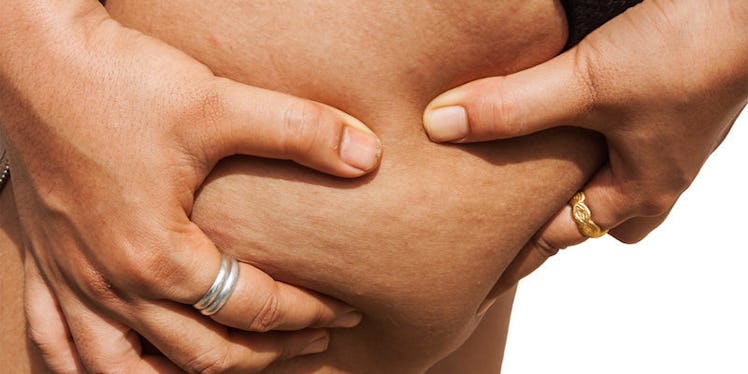
Here Are 8 Things You Should Know About That Annoying Cellulite
Is there anything worse than cellulite?
The cottage cheese, orange peel-like consistency makes you self-conscious in the bedroom, on the beach, in a pair of shorts... the list goes on and on.
The worst part of cellulite, it seems, is how stubborn it is. You lost that last five pounds, but SURPRISE! Your cellulite is still there, cramping your style.
In an effort to help you get rid of (or at least make peace with) your cellulite, we've rounded up some facts.
Here's what you should know.
What is cellulite?
These are the gross details: When the collagen fibers that attach fat to your skin tear, fat cells expand and cellulite appears. In other words, it's pockets of extra fat.
And it's genetic.
Unfortunately, if your mom has cellulite, it doesn't bode well for you. It seems how much cellulite a woman does or doesn't have is determined by genetics.
You won't necessarily have the same amount of cellulite as your mom, though. If she isn't an exercise enthusiast and you are, you'll probably have less body fat and less cellulite.
It's more common in women.
Sorry, ladies. Because of the way a woman's skin is arranged, in parallel, pillar-like rows, it's easier for those fat pockets to develop. Men, on the other hand, have more supportive connective tissue.
As Dr. David McDaniel, a dermatologist at Eastern Virginia Medical School explains to ABC,
If you think of a scaffolding outside a building that has those X crosses on them, that is sort of what men's fat chambers have.
We know. Major bummer.
Tanning makes it worse.
If the arrival of fall has you itching to hit the tanning salon, don't do it! And it's not just because we desperately want to save you from skin cancer.
It's also because spending too much time in the sun will actually make cellulite worse. The damage caused by UV rays breaks down the collagen in the skin, making cellulite more visible.
It's all about SPF, people! And maybe some sunless tanner.
Exercise.
While losing weight won't necessarily reduce cellulite -- even the skinniest women have cellulite, unfortunately -- building muscle can help reduce it. Naturally, you want to build muscle where cellulite appears (in the legs and butt), so focus on those areas.
Don't know where to start? Give some of these exercises a try.
Drink water.
You've probably heard how important it is for your health to stay hydrated. But did you know it also improves the texture of your skin, giving cellulite less of a fighting chance? Yep, it seems staying hydrated can help prevent cellulite and stop it from spreading.
Drink your water, people!
Certain foods could help fight cellulite.
Make sure you eat your veggies... and fruits, olive oil, nuts, seeds and avocados. We know, we know, some of these foods are filled with fat and cellulite is basically pockets of fat.
But when eaten in moderation, these foods actually promote fat loss and help reduce cellulite.
Less delicious foods like sardines, lemons and garlic are also said to help fight cellulite.
Hey, it can't hurt to try.
Try a topical treatment.
There are some mixed messages out there about topical treatments for cellulite. And there's no doubt a lot of them just don't work.
As Mayo Clinic notes,
Creams that contain a variety of ingredients, such as vitamins, minerals, herbal extracts and antioxidants, are often marketed as the cure for cellulite. But no studies show that these creams used by themselves offer any improvement. In some cases, the ingredients in these products cause skin reactions or rashes.
It's not all bad, though.
Jennifer Lucas, M.D., a dermatologist at Cleveland Clinic, says retinol is a great option.
The only topical products shown to help in clinical studies are those containing prescription-strength retinol. With retinol products there is some proof. It thickens skin over time, which may decrease the appearance of cellulite.
Feeling better about that pesky cellulite yet?